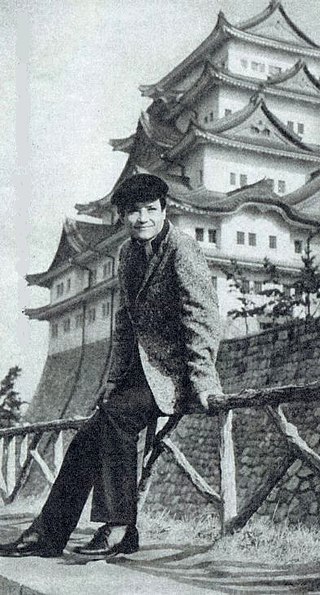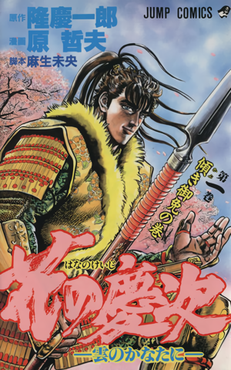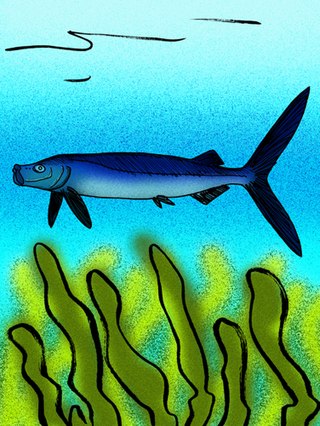Related Research Articles

Akinobu Ogata, better known by his stage name Ken Ogata, was a Japanese actor.

Fist of the North Star is a Japanese manga series written by Buronson and illustrated by Tetsuo Hara. It was serialized in Shueisha's shōnen manga magazine Weekly Shōnen Jump for 245 issues published from 1983 to 1988 and initially collected in 27 tankōbon volumes under the Jump Comics imprint. Set on a post-apocalyptic Earth after a nuclear war, the story centers on a warrior named Kenshiro, the successor of a deadly martial art known as Hokuto Shinken, which gives him the ability to kill his opponents by striking their secret vital points, which often results in an exceptionally violent and gory death. Kenshiro dedicates his life to fighting against the various gangs, bandits, and warlords who threaten the lives of the defenseless and innocent, as well as rival martial artists.

Rebun Island is an island in the Sea of Japan off the northwestern tip of Hokkaidō, Japan. The island sits 50 kilometres (31 mi) off the coast of Hokkaidō. Rebun stretches 29 kilometres (18 mi) from north to south and 8 kilometres (5.0 mi) from east to west. The island covers approximately 80 square kilometres (31 sq mi). Rebun Island is located 10 kilometres (6.2 mi) northwest of Rishiri Island, and the two islands are separated by the Rebun Channel.
Tokiharu Abe was a Japanese ichthyologist and a government official of Ministry of Agriculture and Forestry.
Konoe Hisamichi was a Japanese kugyō of the Muromachi period (1336–1573). He held the regent position of kampaku from 1493 to 1497 and from 1513 to 1514.
Akira Oze is a Japanese manga artist. He made his debut in 1971 under the pen name Megumu Matsumoto (松本めぐむ) writing shōnen manga, but he switched in the 1980s to seinen manga. He is best known for Natsuko's Sake, which was adapted as a live-action television series. Oze won the 1986 Shogakukan Manga Award for shōnen manga for Hatsukoi Scandal and Tobe! Jinrui II.

Hana no Keiji is a Japanese period manga series, based on the novel Ichi-Mu-An Fūryūki by Keiichiro Ryu and illustrated by Tetsuo Hara. It was serialized in Shueisha's Weekly Shōnen Jump from March 1990 to August 1993. The story serves as a fictionalized account of the life of Keiji Maeda. Hana no Keiji is one of best-selling Weekly Shōnen Jump manga series of all time, with over 17 million copies in circulation. An English adaptation was published in Raijin Comics under the shortened title Keiji.
Mycolicibacter nonchromogenicus is an infectious species of bacteria.
The Vialaeaceae are a family of fungi in the Ascomycota and class Sordariomycetes. In 2018, it was placed in the order Amphisphaeriales.
Enteroplax is a genus of air-breathing land snails, terrestrial pulmonate gastropod mollusks in the family Strobilopsidae.
Kanesuke Hara was a Japanese botanist and mycologist.

Kabuse tea, or kabusecha (かぶせ茶) is a class of Japanese tea leaf. Kabuseru (かぶせる) literally means to cover or place on top, as a hat on a head, therefore kabuse tea is a tea leaf harvested from a tea plant that, for some period of time ranging from 2–25 days, has had a porous material draped over the plant while the young leaves are being produced. Kabuse tea is almost exclusively a first flush tea. Though kabuse tea is usually processed into a green tea after picking, kabuse tea denotes a pre-picking process and the freshly picked leaf can be used to produce any kind of tea, from green tea to oolong tea to black tea, or other types.
Iwao Taki was a Japanese malacologist. He described many taxa of Mollusca with Isao Taki, Tadashige Habe and Tokubei Kuroda.

The JapaneseRed List is the Japanese domestic counterpart to the IUCN Red List of Threatened Species. The national Red List is compiled and maintained by the Ministry of the Environment, alongside a separate Red List for marine organisms. Similarly drawing on the relevant scientific authorities, NGOs, and local governments, the Ministry of the Environment also prepares and publishes a Red Data Book that provides further information on species and habitats.

Orii Hyōjirō was a Japanese specimen collector of birds and mammals. At least a hundred new species and subspecies were described based on the type specimens he collected, a 2014 review putting the total, among taxa currently recognized, at 14 species and 41 subspecies of mammal, and 6 species and 68 subspecies of bird. The 7 mammal and 10 bird taxa named in honour of "Orii of the Orient", as he came to be known, include the Ryūkyū shrew and now-extinct Daitō varied tit.

The Musashi ninespine stickleback or Musashi-tomiyo (ムサシトミヨ) is an undescribed fish in the stickleback genus Pungitius. Endemic to Japan, it occurs only in the Motoara River in Kumagaya, Saitama Prefecture. It is the Prefectural Fish, its habitat has been designated a Prefectural Natural Monument, and a main belt asteroid, the minor planet 10776 Musashitomiyo, has been named in its honour. It is assessed as Critically Endangered on the 2020 Ministry of the Environment Red List.

Amakusaichthys is an extinct genus of ichthyodectiform fish which lived during the Late Cretaceous, known from only one species A. goshouraensis. Fossils are known from Kumamoto Prefecture in Japan.
References
- ↑ Lumbsch TH, Huhndorf SM. (December 2007). "Outline of Ascomycota – 2007". Myconet. Chicago, USA: The Field Museum, Department of Botany. 13: 1–58. Archived from the original on March 18, 2009. Retrieved 2015-09-24.
- ↑ Hara, K. (1913). 我國ニ於ケル竹類ノ菌類ノ研究第二(豫報) [Fungi on Japanese bamboo. II]. Botanical Magazine Tokyo. 27 (317): 250–251. doi: 10.15281/jplantres1887.27.317_245 .